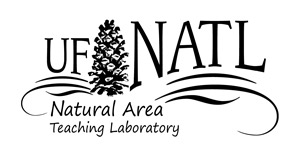| UF Academic Use | Public Use | Family Fun and K-12 Education |

Upland-Pine
Recent improvements in UP infrastructure.
Introduction Management Resources Historical Data
Introduction
Upland pine communities are woodlands characterized by widely spaced longleaf pines with a sparse to moderate shrub layer, along with a dense, species-rich groundcover of grasses and herbs. Other plants commonly occurring in this community are turkey oak, bluejack oak, southern red oak, live oak, persimmon, gopher apple, and leadplant. Animal species include green treefrog, gopher tortoise, eastern fence lizard, red-bellied woodpecker, loggerhead shrike, cotton mouse, and fox squirrel.
This community occurs on ultisol soils that are prominent among rolling hills in the panhandle and in north and central peninsular Florida. The loose, well-drained soils of this community allow rapid downward movement of rainwater into groundwater supplies (aquifer recharge). Fire is a natural and dominant factor in the ecology of this community. In the past, prior to human influence, frequent lightning-ignited fires maintained the structure and rich diversity of these communities. Without the presence of fire, the rich groundcover of these communities will slowly degrade and transition overtime into laurel-oak dominated hammocks. In the development and evolution of this community, the natural fire regime in the area was probably sporadic over the course of millions of years. On average though, prior to human influence, it is generally thought that lightning-ignited fires would have occurred on a frequency of every 1 to 5 years in North FL. Lightning-ignited fires would have also predominately occurred during the late-spring to early summer months (Apr-June) in this area due to frequently dry conditions and the increasing presence of scattered thunderstorms during this seasonal period. Biological adaptations to fire are widely present in this community which includes the thick bark of longleaf pines, which protects adult trees from fire damage. Even seedling trees, with their buds protected by a thick mass of needles, are capable of surviving frequent, light ground fires. Additionally, wiregrass, along with other native grasses and forbs, flower and seed prolifically after late spring and summer burns. Today, much of this community has been converted to other uses such as residential and commercial development, as well as agricultural, and silvicultural operations. Remaining portions of this community on private and public land often suffer from historical fire suppression policies as well.
Management
Upland pine community depends on frequent burning for its continuance. Prior to 1990, NATL's upland pine area had not burned for several decades, allowing weedy fire intolerant species to invade and overwhelm species in the upland-pine community. Significant laurel oak and shrub reductions took place in NATL’s upland-pine area in the mid-1990s. Since then several prescribe fires and plantings of groundcover species have taken place. Being in an urban area makes burning this area difficult and costly to burn through contractors. Since 2019, NATL has started attempts to foster in-house burn management with local partners, which not only saves money but opens learning opportunities for interns and other UF students. Going forward, management will burn this area annually for the foreseeable future to encourage and cement groundcover restoration progress, as well reduce potential for smoke management issues.
Resources
Maps
Pictures
- Semi-annual photos at four restoration sites, 2007-date.
- Photo Gallery of Upland-Pine Ecosystem.
- Poster at start of Upland Pine Nature Trail.
Data
- Diameters of NATL's pines (2008).
- Sam Hart’s detailed phenological and abundance observations for 14 species.
- Sam Hart's list of 227 vascular plants known in NATL's upland pine (2012-2014)
- Coverage of controlled burns (2013-date)
- NATL Plant Inventory (2018-2019)
Historical Data
Documents
- Recent improvements in UP Infrastructure (2015).
- Evidence of cabbage palm invasion (2014).
- Effects of fire on cabbage palm establishment (McPherson & Williams 1998).
- New restoration plan for Block D (2012).
- Update of restoration plan for NATL's upland pine (2007).
- History of NATL's upland pine, 1890 to 1990.
- Upland pine restoration, 1995-2008 (with map).
- Restoration of NATL's upland pine, 1993 to date.
- Principal events in restoration of NATL's upland pine: 1993 to date.
- Form for estimating burn coverage (2015).
- Using SS for calculating average burn coverage (2015).
Maps
- Status of restoration (with map), 2012.
- Restoration islands in NATL's upland pine ecosystem
- Burn coverage maps: 2013, 2014, 2015, 2016
Data


